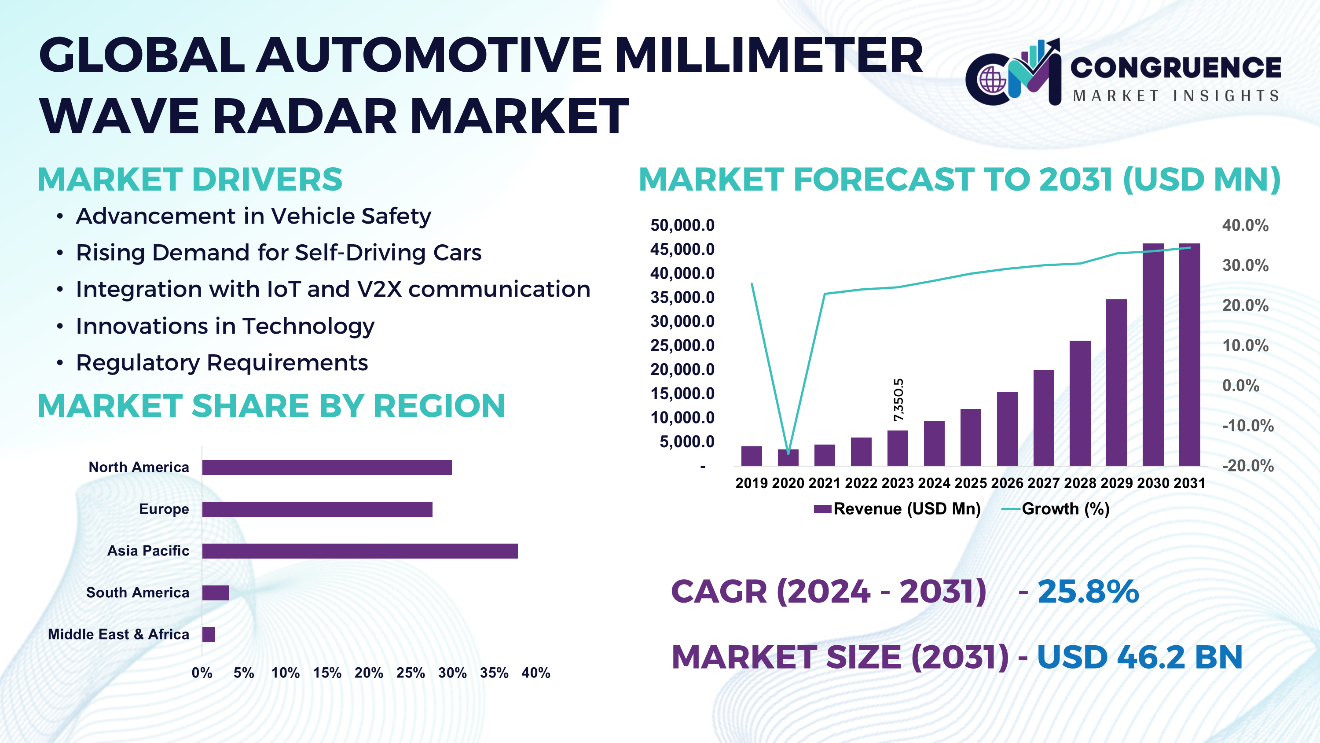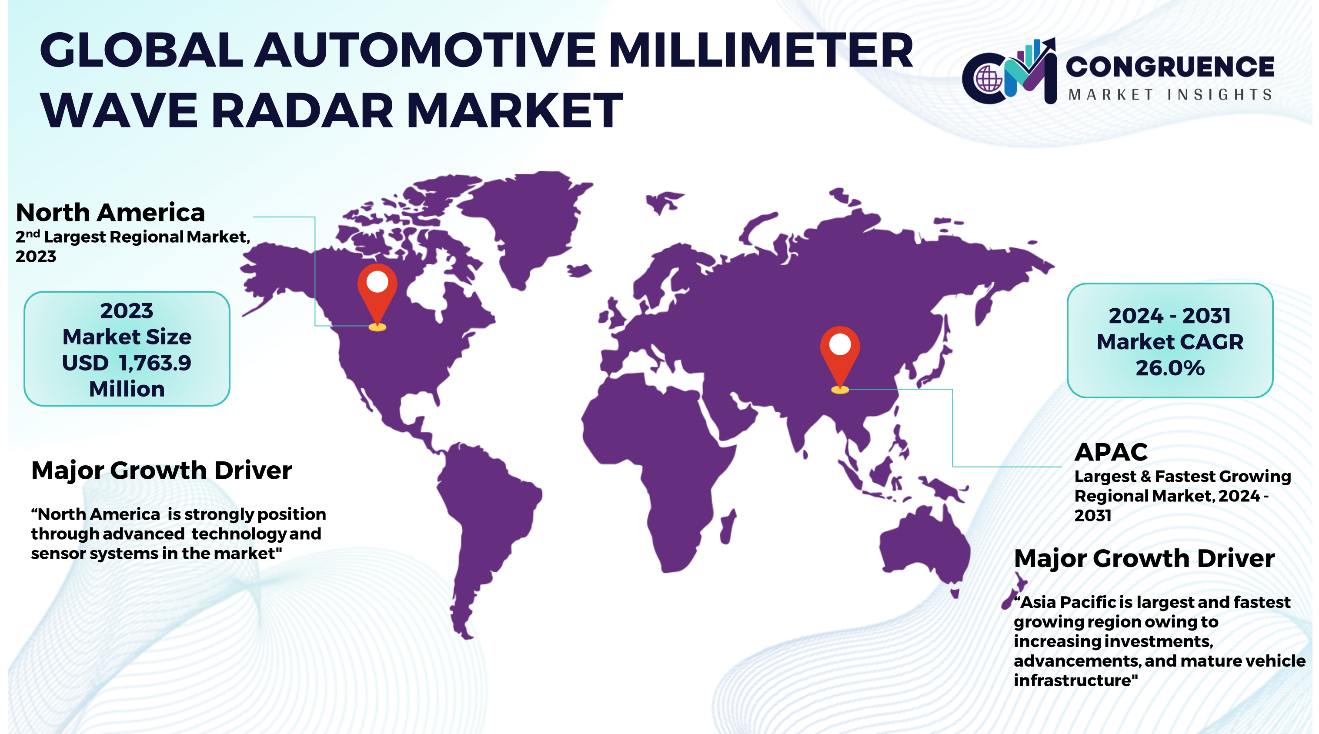Reports
The Global Automotive Millimeter Wave Radar Market was valued at USD 7345.6 Million in 2023 and is anticipated to reach a value of USD 46,281.7 Million by 2031 expanding at a CAGR of 25.8% between 2024 and 2031.
Automotive millimeter wave radar technology represents a key area for the advancements in vehicle safety and autonomy. Integrations into the Internet of Things extend connectivity between the radar sensor and other vehicle systems as well as external devices, allowing for comprehensive Advanced Driver Assistance Systems such as adaptive cruise control, automatic emergency braking, and blind spot detection. Millimeter wave radar also enables Vehicle-to-Everything connectivity, which enables the vehicle to communicate with infrastructure and other vehicles, helping in managing traffic and improving safety. As the market for vehicles expands, so does the demand for electric and autonomous vehicles. This, in turn, also increases the adoption of millimeter wave radar technology by both Original Equipment Manufacturers and aftermarket suppliers, integrating radar systems into vehicles, with OEMs integrating it directly into new models and aftermarket providers offering retrofitting solutions.

To learn more about this report, request a free sample
copy
Automotive Millimeter Wave Radar Market Major Driving Forces
Advancement in Vehicle Safety: Vehicle safety standards are advancing, and the demand for Advanced Driver Assistance Systems (ADAS) pushes the adoption of mm-wave radar technology for the enabling of important features such as adaptive cruise control, collision avoidance, and pedestrian detection.
Rising Demand for Self-Driving Cars: Precise object detection and localization at the millimeter-wave level are basis to the development of fully autonomous and semi-autonomous vehicles, therefore creating the demand for radar systems in automotive.
Integration with IoT and V2X communication: Integration of millimeter wave radar with Internet of Things platforms and V2X will grow the connectivity of vehicles and, thus, enable real-time exchange of data, ultimately improving the level of management of traffic and enhancing the safety level in the process.
Innovations in Technology: Advancements of radar technology, which is helping millimeter wave radar in vehicles to a great extent, are helping with higher resolution and better performance in bad weather conditions.
Regulatory Requirements: The stringent safety regulations and mandates for collision avoidance systems in vehicles are driving the adoption of millimeter wave radar as a critical component for compliance and enhanced safety features.
Automotive Millimeter Wave Radar Market Key Opportunities
Advanced ADAS Systems: ADAS functions such as advanced collision avoidance, cooperative perception, and enhanced parking assistance through enhanced millimeter wave radar technology will make cars safer and enhance the driving experience. Based on autonomous vehicle technologies, millimeter-wave radar systems will have higher levels of vehicle autonomy, enhanced object detection, and real-time environmental mapping.
IoT and V2X Connectivity: Connections to IoT platforms and V2X communication networks will ensure that the vehicle-to-vehicle and vehicle-to-infrastructure connectivity is seamless, enabling cooperative driving and traffic management systems.
Automotive Millimeter Wave Radar Market Key Trends
· Millimeter-wave radar technology has become increasingly popular for the incorporation into advanced driver assistance systems, including adaptive cruise control and collision avoidance features.
· Millimeter-wave radar systems represent an important part of autonomous vehicle technologies. In these technologies, higher levels of vehicle autonomy and safety are achieved.
· In Internet of Things platforms, the millimeter wave radar is integrated. Because of this, vehicle-to-vehicle and vehicle-to-infrastructure communication are much more likely to take place.
· Future radar systems will have higher resolution. It will enable better object detection and mapping of the environment.
· In order to reach more comprehensive vehicle perception capabilities, the integration of millimeter-wave radar with other sensor technologies is used to develop multi-function sensor suites.
· Vehicle-to-everything communication, which is supported by millimeter wave radar systems, makes it possible for cooperative driving and the efficient management of traffic.
· Radar systems are being improved to operate with better performance than in adverse weather conditions for reliable operation in all environments.
· Continued research and development efforts will result in innovative applications of radar and enhanced functionalities.
· In order to develop radar and other sensing technologies, including lidar and cameras, for more comprehensive perception and an enhanced sensing capacity.
· Increasing number of aftermarket applications of radar systems in old vehicles is spreading its market reach and accessibility.
· Radar systems are developed with onboard processing capabilities for efficient real-time decision-making in a vehicle setting.
· There is a growing demand for tailored radar solutions that can meet the requirements of automotive and consumer needs.
· Radar technology can be aligned to smart city infrastructure to achieve enhanced traffic management and safety initiatives.
Region-wise Market Insights
Asia Pacific accounted for the largest market share at 37.8% in 2023 whereas, is expected to register the fastest growth, expanding at a CAGR of 30.0% between 2024 and 2031.

To learn more about this report, request a free sample
copy
Asia-Pacific becomes the growth leader with rapid industrialization, and even increasing automotive production with enhanced adoption of advanced safety technologies. North America also experiences tremendous growth in this regard due to technology advancement coupled with strict safety regulations. Europe continues to hold high market shares due to a strong focus on automotive innovation coupled with regulatory adherence. South America is also projected to be a promising growth region due to rising automotive demand and growing safety awareness. The Middle East and Africa, however, post slower growth due to economic problems as well as limited adoption of advanced automotive technologies in the region.
Market Competition Landscape
Leading players compete vigorously in technological innovation, product diversification, and strategic alliances in order to compete, expand market share, and refine product portfolios. The absence of direct competitors in this competitive environment underlines a dynamic market where companies pay utmost attention to customers' changing needs and regulatory mandates. The solid expertise in radar technology and automotive systems of the leading players goes a long way in meeting these changing demands. In addition to its ability to expand the market through collaborative ventures with OEMs and supply chain partners, this competitive backdrop would ultimately be underscored by a cumulative attitude of excellence and innovation in delivering state-of-the-art radar solutions to the automotive sector.
Key players in the global Automotive Millimeter Wave Radar market implement various organic and inorganic strategies to strengthen and improve their market positioning. Prominent players in the market include:
· Continental AG
· Robert Bosch GmbH
· Denso Corporation
· Autoliv
· Veoneer US Safety Systems, LLC.
· Aptiv
· Infineon Technologies AG
· NXP Semiconductors
· Analog Devices, Inc.
· Gapwaves AB
· MI-Wave
· Renesas Electronics Corporation
· NXP Semiconductors
· Texas Instruments Incorporated
· Nanoradar
· Rohde & Schwarz
· Valeo
· HELLA GmbH & Co. KGaA
· Polarity Inc.
· Panasonic Industry Co., Ltd.
· Hitachi Astemo, Ltd.
· Fujitsu
· Mitsubishi Electric Corporation
· dSPACE GmbH
· Hyundai Motor Company
· Tesla
|
Report Attribute/Metric |
Details |
|
Market Revenue in 2023 |
USD 7345.6.0 Million |
|
Market Revenue in 2031 |
USD 46,281.7 Million |
|
CAGR (2024 – 2031) |
25.8% |
|
Base Year |
2023 |
|
Forecast Period |
2024 – 2031 |
|
Historical Data |
2019 to 2023 |
|
Forecast Unit |
Value (US$ Mn) |
|
Key Report Deliverable |
Revenue Forecast, Growth Trends, Market Dynamics, Segmental Overview, Regional and Country-wise Analysis, Competition Landscape |
|
Segments Covered |
· By Frequency Range (Short Range Radar (SRR), Medium Range Radar (MRR), and Long Range Radar (LRR)) · By Application (Blind Spot Detection (BSD), Lane Departure Warning (LDW), Forward Collision Warning (FCW), Adaptive Cruise Control (ACC), Autonomous Emergency Braking (AEB), and Others) · By Vehicle Type (Passenger, and Commercial) · By Sales Channel (OEMs, and Aftermarket) |
|
Geographies Covered |
North America: U.S., Canada and Mexico Europe: Germany, France, U.K., Italy, Spain, and Rest of Europe Asia Pacific: China, India, Japan, South Korea, Southeast Asia, and Rest of Asia Pacific South America: Brazil, Argentina, and Rest of Latin America Middle East & Africa: GCC Countries, South Africa, and Rest of Middle East & Africa |
|
Key Players Analyzed |
Continental AG, Robert Bosch GmbH, Denso Corporation, Autoliv, Veoneer US Safety Systems, LLC., Aptiv, Infineon Technologies AG, NXP Semiconductors, Analog Devices, Inc., Gapwaves AB, MI-Wave, Renesas Electronics Corporation, NXP Semiconductors, Texas Instruments Incorporated, Nanoradar, Rohde & Schwarz, Valeo, HELLA GmbH & Co. KGaA, Polarity Inc., Panasonic Industry Co., Ltd., Hitachi Astemo, Ltd., Fujitsu, Mitsubishi Electric Corporation, dSPACE GmbH, Hyundai Motor Company, and Tesla |
|
Customization & Pricing |
Available on Request (10% Customization is Free) |
